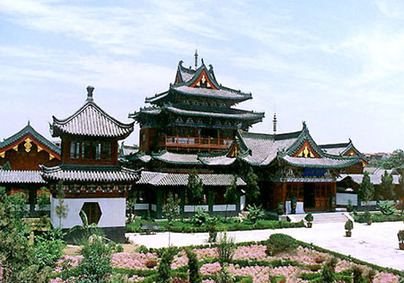Located on the alluvial plains on the middle and lower reaches of the Yellow River, Kaifeng, a key tourism city along the banks of the river, is under the direct jurisdiction of the Henan provincial government. It is 70 kilometers from Zhengzhou in the west, 10 kilometers away from the Yellow River in the north and Longhai Railroad in the south.
The No.310 Tianshui-Lianyungang Expressway, the No.106 Beijing-Shenzhen National Highway and the Zhengzhou-Bianliang Road all run through it. Five counties and five districts are under the jurisdiction of Kaifeng City. The five districts are Gulou District, Longting District, Shunhe District, Nanguan District, and the suburb district; the five counties are Kaifeng County, lankao County, Tongxu County, Qixian County, Weishi County. With a population of 4.3 million, Kaifeng covers an area of 6,444 square kilometers in total, 359 square kilometers of which is urban area.
The major nationalities here are the Han, Hui, Manchu, Mongolian, Tibet, Korean, and Zhuang, of which the Han accounts for 95% of the total population.

Kaifeng, known as "the Capital of Seven Dynasties", is a famous city with a long history, splendid traditions, and a great number of cultural relics and historic sites. It was proclaimed as one of the 24 famous historic and cultural cities by the State Council. Kaifeng was once called Daliang and Bianliang in history.
According to the records of the ancient times, people started to inhabit here as early as in the Neolithic Era. The establishment of Kaifeng City dates back to more than 2,700 years ago in the Xia and Zhou dynasties.
The prosperity of Kaifeng begun in 364 BC with the establishment of the Wei Kingdom, which chose the city, then known as Daliang, as the capital. From then on, the Houliang, Houjin, Houhan and Houzhou all had their capitals in Kaifeng.
Of the seven dynasties that have had their capitals here, it was not until the Northern Song Dynasty (960-1127) that the city really took off. This was Kaifeng's finest period of history, when the city boomed to become the cultural, economic and political center of the country with a population of more than one million.
Trade during this time especially came to the fore. Kaifeng became an unrivaled metropolis even in the whole world. In the Ming Dynasty (1368-1644), Kaifeng was the capital city of Henan Province, and the economic, political and cultural center of the Central Plains.
In the Republic of China Period (1912-1949), Kaifeng remained the capital city of Henan Province. In October 1948, Kaifeng welcomed its liberation and was designated as a special city. In 1954 when the capital city of Henan Province was moved to Zhengzhou, Kaifeng became a city directly under the jurisdiction of the provincial government. In 1983, there were no more districts in Kaifeng, as districts were all changed into counties and under the administration of the city.
Kaifeng retains a lot of the traditional architectural features with the favor of all the dynasties of Song, Yuan, Ming and Qing dynasties.
Besides the many historic sites like the Dragon Pavilion, the Iron Pagoda, the Xiangguo Temple, the newly built Imperial Song Street with a feature of the capital of the Song Dynasty.
Kaifeng also won fame for its paintings and opera. The founders of Su Huang Mi Cai (family names of the four most famous calligraphists in the Chinese history) representing four styles of calligraphy were all from Kaifeng.
The well-known Hebei cuisine originated in Kaifeng. The steamed stuffed bun of the No.1 Restaurant, the lightly fried dumpling of the Daoxiang Store, and the steamed dumpling of the Youyixin Restaurant are listed as excellent snaps of China.
